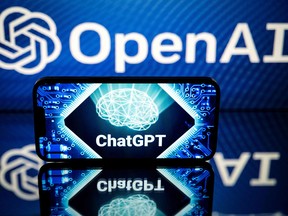Goldman Sachs has estimated a quarter of all tasks will be exposed to AI takeover, putting 300 million jobs globally at risk
Article content
By David Rosenberg and Julia Wendling
Advertisement 2
Article content
The rise of generative artificial intelligence (AI) and its potential economic impacts have been all over the headlines ever since the release of OpenAI LLC’s ground-breaking ChatGPT software back in November 2022. As a result, we thought it prudent to delve into how the new wave of generative AI is set to revolutionize the economy, and which industries are most likely to be affected by the associated technological advancements.
Article content
The bottom line is that productivity will undoubtedly receive a boost — as bots are increasingly able to perform repetitive and time-consuming tasks with human-level speed and accuracy (or greater) — but that labour displacement among many white-collar jobs is likely to be a painful casualty of the shift. This is where the greatest upheaval is going to be — on the labour market.
Advertisement 3
Article content
Those who cling to some “new era” world coming out of the pandemic of labour shortages, worker power and never-ending inflationary wage growth are missing a very important and powerful disinflationary theme that will turn the jobs market on its head and give the economy a 1990s style productivity boost. Those folks who left the labour market to pursue their bucket lists and live life to the fullest are going to find that when it comes time to go back to work, the only jobs that will be available for them will be at eateries, theme parks and hotels.
What is generative AI?
Generative AI refers to a broad category of machine learning technology that creates content/output based on a vast array of data and information that it has been fed. What sets generative AI apart from its predecessors is that, unlike traditional AI systems that are primarily used to make predictions based on detected patterns, this wave of the technology is able to generate new content (text, images, audio, etc.). That said, the current phase of generative AI is only able to perform a small subset of tasks to the same degree of efficiency and accuracy as humans. But if the trend of improving tech continues along the predicted path, many experts in the field believe that by 2060, AI capabilities will have surpassed human cognitive power.
Article content
Advertisement 4
Article content
What are the economic benefits of generative AI?
As with previous waves of disruptive technology, generative AI will lead to a boost in productivity as it becomes more integrated with business practices. Theoretically, with the systems performing mundane and repetitive tasks on behalf of humans, more time can be freed up to take on additional projects that involve a higher degree of skills and creativity. That’s a trend we have observed throughout history with the invention of the internet, Microsoft Corp.’s suite of Office products, and other tools that have become crucial to many workers’ day-to-day operations. Quantifying the positive impact on productivity is a difficult (if not impossible) task, but early research indicates that its effects could surpass that of the invention of the internet at the end of the 20th century (63 per cent of those polled in PricewaterhouseCoopers LLP’s annual Global CEO Survey believe that AI will have a greater economic impact than the internet).
Advertisement 5
Article content
On the conservative end, Goldman Sachs Group Inc. estimates that global gross domestic product will rise by seven per cent over a 10-year period due to the technology. In contrast, researchers at the World Economic Forum are calling for a larger 26 per cent boost to global economic output by 2030 (amounting to US$15.7 trillion — larger than China and India’s GDP combined). And while the exact figure is up for debate, the view that generative AI will increase economic activity and productivity is virtually unanimous.
How will generative AI affect the labour market?
There is no denying that one side effect of generative AI becoming more ubiquitous is labour market displacement, and potentially higher levels of unemployment on the horizon. However, it should be noted, on a more optimistic note, that the internet sparked similar fears several decades ago, and ended up creating millions of jobs in the United States and now accounts for 10 per cent of the nation’s GDP — though it is unlikely the path taken by AI will be as rosy.
Advertisement 6
Article content
The sort of AI technology we are talking about today has much more acute labour displacement characteristics because we are talking about a generation of analysts in any profession, for example, being totally replaced. And the cost savings will be incredible. But the mounting unemployment that will ensue, that not even U.S. Federal Reserve chair Jay Powell is contemplating because he is so intensely focused on today’s labour market instead of the future, is sure to pressure governments to finally buckle and embark on a road of a minimum guaranteed income system.
That said, the harmful and beneficial effects of the technology will not be felt evenly across the labour market, meaning workers in some industries stand to lose out while others gain. The difference this time around is that while blue-collar workers bore the brunt of the impact in previous waves of technological advancements, white-collar workers look set to be more heavily displaced this time around, with data entry, administrative support, accounting, mathematicians, and financial services topping the list of most affected professions.
Advertisement 7
Article content
Regardless, the vast majority of workers will be impacted. Goldman Sachs has estimated one-quarter of all tasks will be exposed to AI takeover, putting 300 million full-time positions globally at risk of automation. For the U.S. specifically, the prediction is that 63 per cent of the corporate sector will see almost half its workload affected by AI. Only 30 per cent will emerge unscathed (primarily jobs involving physical labour and human touch elements), while seven per cent will undergo complete replacement. And seven per cent of a U.S. workforce that totals 160 million is not a small number.
What this means is that we could ultimately see a scenario where a greater portion of the workforce is permanently displaced and income inequality worsens, leading to declining labour share (compensation divided by total output), greater social/political unrest and, as we mentioned, putting discussions of universal basic income (UBI) back on the front burner. How fiscal authorities make room for this additional future budgetary requirement in the face of an ever-challenging dependency ratio will be fascinating to see. Maybe modern monetary theory (MMT) comes back to the fore as well (though the U.S. will merely just become more Canadian in nature and become Robin Hood — the Justin Trudeau government can surely give American policymakers a lesson on that!).
Advertisement 8
Article content
Conclusion: A net positive or negative?
Ultimately, whether the overall effects on the global macroeconomic economy are positive or negative on net following the wave of generative AI remains to be seen. While productivity is sure to gain, the question mark surrounding the effects on the labour market is what is really important, both for the economy and for society.
There is not nearly as much focus on the coming upheaval in the labour market. All we know is that this is a major deflationary event at a time when the pandemic and all the reckless policy largess has caused the majority of market participants to believe we are into some sort of structural inflationary future. The problem with human nature is extrapolating the latest experience into the future. A very big mistake in our view.
Advertisement 9
Article content
-

Management takes a knife to earnings estimates
-

What comes after a peak yield curve inversion? Nothing good
-

David Rosenberg: The earnings recession is underway
In terms of supply-side dynamics, if generative AI follows in the footsteps of the internet, human labour could be augmented by its implementation and pave the way for the creation of more high-skill/high-paying jobs and would be a boon for potential GDP growth. Disinflationary. On the aggregate demand front, widespread labour replacement could lead to a wave of unemployment, depressing consumption spending in the process. Again, disinflationary.
David Rosenberg is founder of independent research firm Rosenberg Research & Associates Inc. Julia Wendling is an economist there. To receive more of David Rosenberg’s insights and analysis, you can sign up for a complimentary, one-month trial on the Rosenberg Research website.
_____________________________________________________________
If you like this story, sign up for the FP Investor Newsletter.
_____________________________________________________________
White-collar jobs will be casualty of AI revolution
2023-04-10 15:42:22







Comments
Postmedia is committed to maintaining a lively but civil forum for discussion and encourage all readers to share their views on our articles. Comments may take up to an hour for moderation before appearing on the site. We ask you to keep your comments relevant and respectful. We have enabled email notifications—you will now receive an email if you receive a reply to your comment, there is an update to a comment thread you follow or if a user you follow comments. Visit our Community Guidelines for more information and details on how to adjust your email settings.
Join the Conversation